#far east cinema
Photo


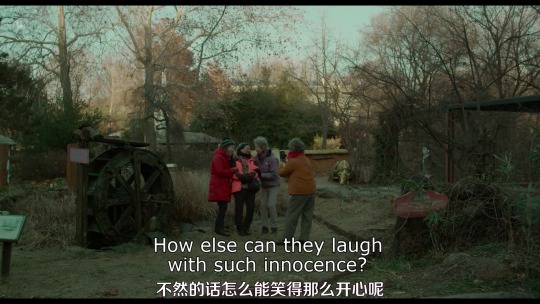
찬실이는 복도 많지 [Lucky Chan-sil] (Kim Cho-hee - 2019)
#찬실이는 복도 많지#Lucky Chan-sil#Kim Cho-hee#innocence#South Korean movies#Kang Mal-geum#Youn Yuh-jung#forget#Chansilineun bokdo manhji#Kim Young-min#Yoon Seung-ah#Cinema of South Korea#Bae Yoo-ram#expectations#simple#Far east cinema#disappoinment#Choi Hwa-jung#relationship#romantic drama film#Lee Young-jin#fantasy film#friendship#La fortunata Chan-Sil#Korean society#Korean culture#love#チャンシルさんには福が多いね#wisdom#Anastasiia Sokolova
225 notes
·
View notes
Text
A Far Out Look at Gaby Teller's Costumes in the Man from U.N.C.L.E.
The fashion in this movie is amazing, let's talk about specifically what Gaby is wearing and what it tells us about her character.

We meet Gaby working as a mechanic in East Berlin. So obviously the this the least put-together we ever see her. I couldn't get a good picture of her jumpsuit but it seems pretty standard. The scarf in her hair is rather fashionable, hinting at what is to come.
Female representation: 10/10 It looks mostly like what a real mechanic would wear, with nothing to emphasize that she is a female mechanic (other than her nice scarf).
Practicality: 10/10 Presumably the most practical thing we see anyone wear in this movie

This is one of the dresses she tries on while getting under cover. I wish we had gotten more of a montage of her different outfits but this one is pretty fun. It is a vast improvement over the one Solo had her wear first. The orange coordinates with what she wears in the climax, which is fun. And perhaps a nod to the fact that she is playing a part here as much as she will be then.
The dresses she wears going forward are all of the same style, chosen to be both 60s and modern. Watch this video by Cinema Cities for more on the choices made for the costuming. As is discussed there, the choices for Gaby are young and fresh, with bright colors. Geometric patterns, mod shape, an emphasis on legs instead of the hourglass. She stands out from the other leading lady, whose costuming is very complex - doing the most with her hair, make-up, accessories. Gaby, on the other hand, tends to wear earrings and a ring or a bracelet.
Female representation: 10/10 She looks fantastic, even for this short scene in the boutique, and is a spy being outfitted to go undercover. This scene establishes what her style is without deciding to ogle her at any point.
Practicality: 9/10 Compared to the jumpsuit, it's obviously less practical but it's pretty great in general.

Now undercover in Rome, Gaby wears a white dress with an overcoat that we also see worn with the other dresses. Both are very stylish and fit the silhouette that was popular in the 60s. As far as being fully white goes, that makes sense for a scene in which she is out for a walk with her assigned fiancé, making sure that their cover is convincing (even when they are mugged). White emphasizes her status as a pawn in the game right now (as does the shape of the outfit), as well as implying a woman in need of rescue. It is effective way to trick both their marks and her fellow spies into considering her to be helpless.
Female representation: 10/10 Still fantastic, gonna break my rating system. She looks good but is not eye-candy despite her role in the film.
Practicality: 9/10 The coat doesn't seem especially warm but the ensemble is certainly practical for what she is doing.
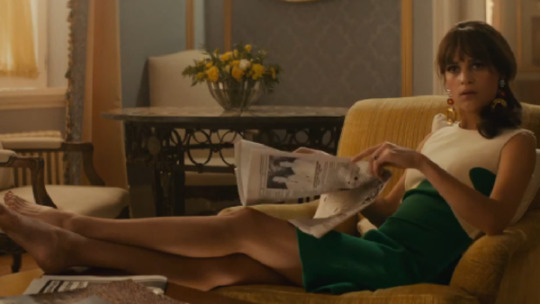
She wears this dress to the races, including a large hat, to meet with Uncle Rudi as well as Alexander Vinciguerra. It is her first job as a spy and this dress reflects that. Instead of pure white, most of it is green, a color generally associated with duplicity (like a snake). The scene includes Gaby doing quite a bit of angling to move the mission forward, which involves playing up what Solo and Kuryakin believe she is there to do as well as her own agenda, so while she isn't exactly a double agent, she is certainly deep in the plot.
Female representation: 10/10 These are all great, what can I say?
Practicality: 9/10 As above, perhaps not as useful as her jumpsuit, especially considering she does work on a car in this scene. But it certainly serves her purposes.

I couldn't find a photo, but I couldn't leave out her charming pajamas. She wears these in two scenes with Illya Kuryakin, when they are hanging out in their hotel room. The first night, she insists he dance with her and the second night she appears to betray him. So the outfit itself is mostly grey, since we can't be sure what her motivation is (until later in the movie). Plus they look like great pajamas, especially for being undercover and having to share a room with a stranger.
Female representation: 10/10 Some of the best pajamas I've seen a lady wear on film, especially for a spy movie.
Practicality: 10/10 They seem to be very practical, especially for wrestling.

And here is the showstopper. Gaby wears this for the climax of the film, through a lot of twists and turns. It is the same silhouette as the others, though the neckline is a bit more formal. Following the theme of the last dress, she started in white and now appears to have added a lot of cover on top of the white. The pattern is also reminiscent of camouflage. This makes sense because now is when her status as an agent all along is revealed, as she appears to betray first Kuryakin and Solo and then deceives the Vinciguerras along with her father. Again, she has minimal accessories in contrast to Victoria and she sets herself apart from everyone else in this outfit as she does so in the movie as well.
Female representation: 10/10 For a double-agent and/or damsel in distress, she is very well dressed indeed
Practicality: 9/10 It works well enough but I'm sure she wishes she had something else to wear when they are going off road through the rain.
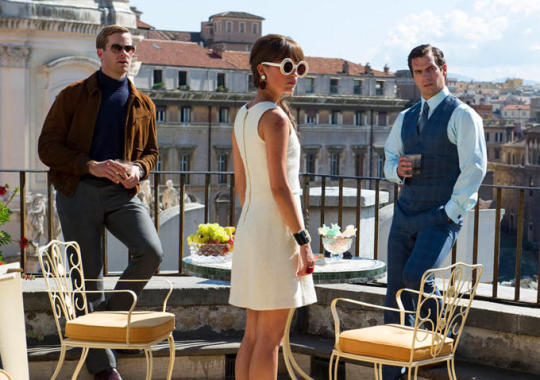
The final shot, where the team is now put all together. The show features just the gentlemen and it's great to have her be at the center (the lack of a sequel is devastating). She is back to wearing a white dress, now that her true role in the story has been revealed and she made a significant contribution to the cause in the process.
Female representation: 10/10 Again, it is fantastic, especially for the female member of the spy team
Practicality: 9/10 Same as the others, I daresay
Want to hear more of my thoughts about female characters and fashion? Check out my other costume reviews or my YouTube channel (episode on Gaby coming Friday!)
31 notes
·
View notes
Text
THIS DAY IN GAY HISTORY
based on: The White Crane Institute's 'Gay Wisdom', Gay Birthdays, Gay For Today, Famous GLBT, glbt-Gay Encylopedia, Today in Gay History, Wikipedia, and more … February 19




1902 – F.O. (Francis Otto) Matthiessen was an educator, scholar and literary critic influential in the fields of American literature and American studies. (d.1950) The exchange of letters between him and his lover Russell Cheney are among the most revealing gay male documents of the 1920s.
Born in Pasadena, California, after his parents' divorce in 1915, Matthiessen lived on his grandfather's farm in Illinois, later attended boarding school in Tarrytown, New York. Toward the end of World War I, joined the Canadian Air Force. He entered Yale in 1919, where he was a member of Skull and Bones society, and graduated in 1923 with many honors, and then became a Rhodes Scholar at Oxford, receiving a B. Litt. in 1925.
Matthiessen's best-known book, American Renaissance: Art and Expression in the Age of Emerson and Whitman (1941), discusses the flowering of literary culture in the middle of the American 19th century, with Emerson, Thoreau, Melville, Whitman and Nathaniel Hawthorne.
While sailing for Oxford, he met the painter Russell Cheney; they would be lovers until Cheney's death in 1945. Cheney, though closeted in many ways, was a profoundly positive influence on Matthiessen, encouraging his interest in gay and lesbian literary figures like Walt Whitman and Sarah Orne Jewett.
The couple shared a cottage in Kittery, Maine for decades. In planning to spend his life with Cheney, Matthiessen went as far as asking his cohort in the Yale secret society Skull and Bones to approve of their partnership. With Cheney having encouraged Matthiessen's interest in Whitman, it has been argued that American Renaissance was "the ultimate expression of Matthiessen's love for Cheney and a secret celebration of the gay artist."
Matthiessen, as a gay man in the 1930s and 1940s, chose to remain in the closet throughout his professional career, if not in his personal life - although traces of homoerotic concern are apparent in his writings. In 2009, a statement from Harvard University said that Matthiessen "stands out as an unusual example of a gay man who lived his sexuality as an 'open secret' in the mid-20th century."
After Cheney's death in 1945, Matthiessen was increasingly distraught; he committed suicide by jumping from a window in 1950. Because Matthiessen's politics were left-wing, socialist, though not dogmatically Marxist, inquiries by House Un-American Activities Committee into his politics may also have been a factor in his suicide: writing in 1958, Eric Jacobsen referred to Matthiessen's death as "hastened by forces whose activities earned for themselves the sobriquet un-American which they sought so assiduously to fasten on others".


1921 – Dudley Cave was a British former soldier and pioneering gay rights activist (d.1999). He joined the Royal Army Ordnance Corps in 1941, aged 20, and was posted to the Far East. He was captured by the Japanese when Singapore fell in 1942 and was marched north to work on the Thai-Burma railway, 10 miles beyond the bridge on the River Kwai. He caught malaria and was imprisoned in Changi Prison in Singapore because he was unproductive. This may have saved his life. Three quarters of his company perished.
When back in Britain he had a job as manager of the Majestic Cinema, Wembley, but in 1954 he was sacked when it was discovered that he was gay. Also in 1954 he met Bernard Williams, an RAF veteran and school teacher, and they became lovers and co-campaigners for 40 years until Bernard Williams died in 1994.
In 1971 Dudley Cave joined the Unitarian Church and helped in securing the ordination of lesbians and gay men. He also conducted same-sex weddings.
In 1974 he was on the launch committee of the London Gay Switchboard, and he was still answering the telephone right up to his death 25 years later.
He and his partner, Bernard Williams, founded the Lesbian and Gay Bereavement Project in 1980, and they ran its telephone helpline for many years. After a battle with the Charity Commissioners this became the first organisation with 'gay' in its title to be given charitable status.
In the 1980s he worked on reconciliation with the Japanese and travelled a number of times to Japan to speak on the subject.
In November, 1998 he was OutRage!'s keynote speaker at its Queer Remembrance Day vigil at the Cenotaph where he layed a pink triangle wreath honouring gay people who died fighting Nazism and in the concentration camps.
Dudley Cave dedicated most of his life to challenging and fighting prejudice and seeking justice and equality for gay people especially in the areas of military recognition and issues of bereavement for gay people of all ages; he did so with great eloquence, dignity and integrity.


1925 – J. J. Belanger (d.1993) was member and officer in the Mattachine Society in the 1950s and 1960s, a volunteer in numerous causes in the 1970s and 1980s, and a collector of LGBT history, especially of AIDS-related materials of the mid-to-late 1980s.
The famous photo booth photo of J.J. Belanger above was rediscovered in 2014 and spread quickly through popular media such as The Advocate, TIME, Queerty, and blogs. It shows Robert Block and J. J. Belanger (right) in a photo booth photo in Hastings Park, Vancouver, British Columbia, 1953. It was taken at a time in Canadian history when the two men could have been arrested for kissing.
Joseph John Bertrund Belanger was born February 19, 1925, in Edmonton, Canada. He served in the Royal Canadian Air Force from 1942 to 1944 where he was awarded a Defense Medal, Canadian Voluntary Service Medal, and War Medal for his World War II service. He worked odd jobs in Vancouver and Calgary until 1954 when he joined the United States Air Force. He served for five years, earning the Aviation Badge, Good Conduct Medal, Outstanding Airman of the 26th Air Refueling Squadron, numerous other commendations, and a promotion.
Belanger became a member of the Mattachine Society in the early 1950s, but resigned in 1953 after an incident with police threatened to bring negative publicity to the organization. However, Belanger maintained contact with Hal Call and in 1958 became the Mattachine Society's Director of Public Relations. In 1959 he was voted out of the post, but still remained a member of the society.
From the 1950s Belanger lived in either San Francisco and Los Angeles, although the particulars of his life are documented only sporadically. He was the Los Angeles coordinator of the Eulenspiegel Society in the 1970s. In the 1980s he was politically involved with the San Francisco chapter of the Stonewall Gay Democratic Club, where he ran and lost a bid for treasurer in 1988. Also in the 1980s he volunteered for Project Inform and was a member of the Quarantine Fighter’s Group. Belanger was also a devoted collector of LGBT history, especially of AIDS-related materials of the mid-to-late 1980s.


Curtis in drag
1947 – John Holder Jr, better known as Jackie Curtis, was a famous transgendered film star, poet and playwright. (d.1985)
Curtis was born in New York City, and later died there of a drug overdose. He spent part of his life living and performing as a man (sometimes adopting a James Dean persona) and sometimes as a woman.
While living and performing in drag, she would typically wear lipstick, glitter around the eyes and in her frizzed-out red hair, and a dress, frequently ripped and torn, as were her stockings. This unique style, a combination of trash and glamour which Curtis pioneered in the late 1960s when frequenting such high profile nightclubs as Max's Kansas City, has prompted assertions that Jackie inspired the Glam Rock persona of the 1970s.
'Jackie Curtis is not a drag queen. Jackie is an artist. A pioneer without a frontier,' Andy Warhol said of his associate. Primarily a stage actor, Curtis debuted at the age of 17 in Tom Eyen's play Miss Neferititi Regrets. Curtis began to write his own plays immediately after this experience, often featuring famous transsexuals, such as his friend Candy Darling and, later, Holly Woodlawn, both of whom appeared in his productions which enjoyed successful runs Off-Off-Broadway and were well-reviewed in New York. Curtis's work is representative of the Theatre of the Ridiculous.
As writer and lead actress some of her plays include: Glamour, Glory and Gold; Amerika Cleopatra which featured Harvey Fierstein; Femme Fatale; and Heaven Grand In Amber Orbit with Holly Woodlawn, produced by John Vaccaro's Playhouse of the Ridiculous in 1970.
These plays caught the attention of Andy Warhol and his director Paul Morrissey, who cast Jackie and Candy in Flesh (1968) and, with the addition of Holly Woodlawn, in Women in Revolt (1971); a hilarious spoof of the women's liberation movement in which all the female leads are played by transsexuals and transvestites.
Apart from acting, Curtis also showed talent in poetry and singing. Jackie Curtis made two more movies during the 1980s. Drug addiction, however, had taken control of Curtis's life, eventually leading to his death.
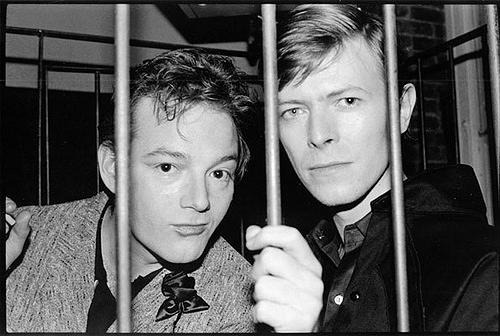
In 2004, a film based on Curtis's life, Superstar in a Housedress, brought Jackie Curtis back to the limelight, exposing some little known facts about the performer to the public. Curtis's influence on a number of people, friends and associates such as Holly Woodlawn, Joe Dallesandro and Penny Arcade, and observers such as David Bowie, is noted in the film.


1952 – California artist Lari Pittman creates visually beautiful and exciting paintings that depict the anxiety attendant on being a gay male in America. They confront the perils and dangers that threaten homosexuality even as they resolutely affirm homosexual love.
Lari Pittman was born in Glendale, California. Pittman spent much of his childhood in the Colombian cities of Cali and Tumace, where his father worked in the lumber industry. An effeminate child, he loved playing with his mother's jewelry. His desire to decorate with baubles received parental support and has deeply influenced his subsequent art.
After studying painting at University of California, Los Angeles from 1970 to 1973, Pittman transferred to the California Institute of Arts. Pittman held his first solo exhibition in 1982 to mixed reactions. His early works, full of obscure references, are purposely made to be difficult for the viewer to decipher.
In 1985, Pittman changed his style as the result of suffering a near fatal attack. One night, he discovered a burglar in his home. When he attempted to scare off the man, he was shot in the stomach. The injury resulted in a colostomy and a long period of recovery. After this harrowing, near death experience, Pittman decided to stop being evasive about his homosexuality and about the thematics of his work. He has since sought to erase the distinction between the private and the public as a means of gay activism.
Pittman's post-1985 imagery is much more open and readable than his earlier imagery. In This Wholesomeness, Beloved and Despised, Continues Regardless (1990), for example, he creates a complex narrative through the use of accessible images. At the center of this canvas is a gay couple making love. However, the decorative elements in the painting are both celebratory and ominous, ranging from an inscribed "69" (a motif he uses in several works) to a noose and a menacing figure wielding a knife. Thus, the work's narrative structure celebrates gay relationships, but also acknowledges the homophobic conditions in which they are experienced. The painting makes an affecting statement about the persistence and perseverance of gay love even in the face of hatred and persecution.

"In This Wholesomeness …
Pittman's paintings consider American identity and history, often incorporating motifs from folk art and popular culture, as in An American Place (1986). Such motifs give his work a cartoon-like quality, with every space packed with imagery and action.

An American Place
The emphasis that Pittman places on queerness has led some critics to describe him as the prince of queer agit-prop art. He has been attacked for being too political because he has dared to address the difficulties of life as a gay man in paintings that grab attention. Indeed, Pittman may be justly regarded as our foremost painter of gay pride.
He lives in Los Angles with his longtime companion, fellow artist Roy Dowell, with whom he sometimes collaborates.


1987 – Jeffery Self is an American actor, writer, and comedian.
Self is a native of Georgia, who grew up in the South. After attending middle school, Self persuaded his parents to let him be homeschooled to avoid dealing in high school with the fact that he was gay.
Self has appeared in many television shows as a recurring, featured or guest actor. He and Cole Escola starred in the sketch comedy series Jeffery & Cole Casserole, which aired on Logo TV for two seasons. He has also appeared in Desperate Housewives, 90210, Hot In Cleveland, Torchwood, Shameless, Difficult People, and as Liz Lemon's cousin Randy Lemon on NBC's 30 Rock. He is the author of two humor books: Fifty Shades Of Gay and Straight People: A Spotters Guide, as well as the young adult novels A Very Very Bad Thing and Drag Teen. He co-wrote, produced, and starred in the indie horror/comedy cult hit You're Killing Me. He was the host of the MTV series, Scream: After Dark, a talk show devoted to deleted scenes and interviews with the cast of the popular MTV horror series Scream. He currently plays Marc Doober on Search Party on TBS.
Self is openly gay. He dated Patrick McDonald of Fire Island for three years and publicly blogged about their breakup. On January 8, 2017, Self and his boyfriend, Augustus Prew, announced their engagement via Instagram. They were married on January 13, 2018 in Culver City, California.


1993 – The Crying Game, a film written and directed by Neil Jordan, portrays the relationship between a transsexual woman and an IRA fighter in London. In 1999, the British Film Institute named it the 26th greatest British film of all time.

2007 – In New Jersey the first same-sex couple, Daniel Gross and Steven Goldstein, held a civil union ceremony when hundreds of Gay couples were granted the same legal rights, if not the title, as married couples as New Jersey became the third state to offer civil unions.


24 notes
·
View notes
Photo
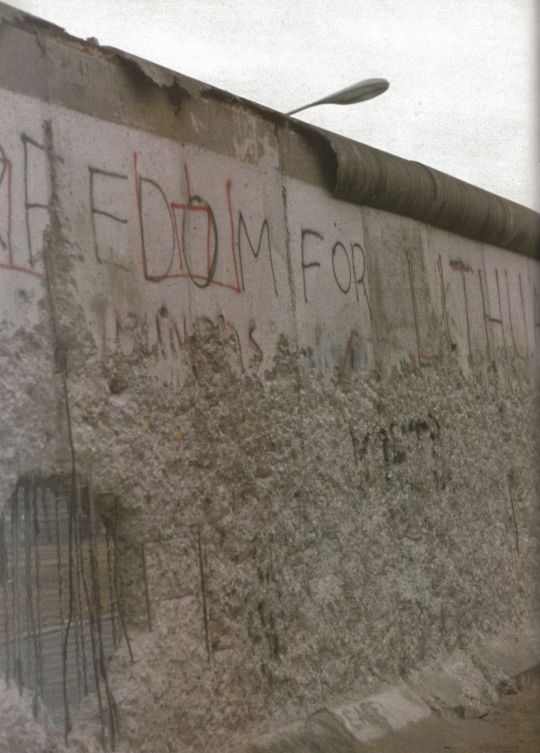

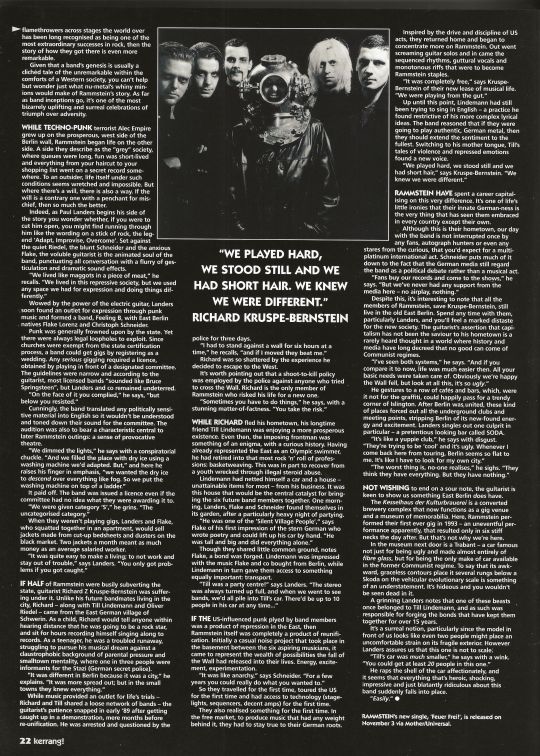
KERRANG! - 12 October 2002
For Rammstein, growing up behind the Berlin Wall was a matter of life or death. Their incredible story can finally be told…
From the outside, East Berlin looks like any other prosperous Western city. Take the road to it from Schonfeld airport and the neon glow of petrol stations, fast-food chains, shopping malls and multiplex cinemas all flit reassuringly by. Near the centre, the glitzy communications tower looks positively sci-fi.
Get in closer, and the picture is less pristine. For every sign of new investment, there are as many examples of the old. Crumbling buildings — prison grey and rotting from the former Communist regime — serve as a reminder that the Wall which divided East and West since the Second World War is barely a decade gone. Graffiti covers every surface.
In the Prenzlauer district, this gulf between old and new is particularly striking. Brightly-colored apartment blocks and cafés sit right next to these corroding structures — half of which look like they might disintegrate at any moment. We are warned that the balconies dangling precariously from them have been known to descend into the street without warning.
It’s beneath such a balcony that we find Rammstein — a band renowned for reducing things to rubble.
Seemingly unaware of the latent doom scenario above theirs heads, four out of the six members — that’s guitarist Paul Landers, bassist Oliver Riedel, drummer Christoph Schneider and keyboardist Christian ‘Flake’ Lorenz — are sitting outside a curry house. Second guitarist Richard Z Kruspe-Bernstein is absent, having just moved to New York with his wife, although he literally phones in an appearance late. Press-shy meat-stack Till Lindemann is simply absent and uncontactable.
This is the first time the band have been back in their hometown for any length of time, following their punishing pan-continental touring schedule in support of ‘Mutter’. The atmosphere is relaxed. As everyone points out, this rare bit of downtime has allowed the band to focus on some extra-Rammstein issues. These include therapy, fatherhood, holidays in the sun, and a spot of interior decorating.
Still, these men are gathered here today to discuss Rammstein. If the exploits of six German and their flamethrowers across stages the world over has been long recognized as being one of the most extraordinary successes in rock, then the story of his they got there is even more remarkable.
Given that a band’s genesis is usually a clichéd tale of the unremarkable within the comfort of a Western society, you can’t help but wonder just what nu-metal’s whiny minions would make of Rammstein’s story. As far as band inceptions go, it’s one of the most bizarrely uplifting and surreal celebrations of triumph over adversity.
While techno-punk terrorist Alec Empire grew up on the prosperous, west side of the Berlin Wall, Rammstein began life on the other side. A side they describe as the ‘grey’ society, where queues were long, fun was short-lived and everything from your haircut to your shopping list went on a secret record somewhere. To an outsider, life itself under such conditions seems wretched and impossible. But where there’s a will, there is also a way. If the will is a contrary one with a penchant for mischief, then so much the better.
Indeed, as Paul Landers begins his side of the story you wonder whether, if you were to cut him ope, you might find running through him like the wording on a stick of rock, the legend ‘Adapt, Improvise, Overcome’. Set against the quiet Riedel, the blunt Schneider and the anxious Flake, the voluble guitarist is the animated soul of the band, punctuating all conversation with a flurry of gesticulation and dramatic sound effects.
“We lived like maggots in a piece of meat,” he recalls. “We lived in this repressive society, but we used any space we had for expression and doing things differently.”
Wowed by the power of the electric guitar, Landers soon found an outlet for expression through punk music and formed a band, Feeling B, with East Berlin natives Flake Lorenz and Christoph Schneider.
Punk was generally frowned upon by the state. Yet there were always legal loopholes to exploit. Since churches were exempt from the state certification process, a band could get gigs by registering as a wedding. Any serious gigging required a licence, obtained by playing in front of a designed committee. The guidelines were narrow and according to the guitarist, most licensed bands “sounded like Bruce Springsteen”, but Landers and co remained undeterred.
“On the face of it you complied,” he says, “but below you resisted.”
Cunningly, the band translated any politically sensitive material into English so it wouldn’t be understood and toned down their sound for the committee. The audition was also to bear a characteristic central to later Rammstein outings: a sense of provocative theatre.
“We dimmed the lights,” he says with a conspiratorial chuckle. “And we filled the place with dry ice using a washing machine we’d adapted. But,” and here he raises his finger in emphasis, “we wanted the dry ice to descend over everything like fog. So we put the washing machine on top of a ladder.”
It paid off. The band was issued a licence even if the committee had no idea what they were awarding it to. “We were given category ’S’,” he grins. “The uncategorized category.”
When they weren’t playing gigs, Landers and Flake, who squatted together in an apartment, would sell jackets made from cut-up bedsheets and dusters on the black market. Two jackets a month meant as much money as an average salaried worker.
“It was quite easy to make a living; to not work and stay out of trouble,” says Landers. “You only got problems if you got caught.”
If half of Rammstein were busily subverting the state, guitarist Richard Z Kruspe-Bernstein was suffering under it. Unlike his future bandmates living in the city, Richard — along with Till Lindemann and Oliver Riedel — came from the East German village of Schwerin. As a child, Richard would tell anyone within hearing distance that he was going to be a rock star, and sit for hours recording himself singing along to records. As a teenager, he was a troubled runaway, struggling to pursue his musical dream against a claustrophobic background of parental pressure and small-town mentality, where one in the three people were informants for the Stasi (German secret police).
“It was different in Berlin because it was a city,” he explains. “It was more spread out; but in the small towns they knew everything.”
While music provided an outlet for life’s trials — Richard and Till shared a loose network of bands — the guitarist’s patience snapped in early ’89 after getting caught up in a demonstration, mere months before re-unification. He was arrested and questioned by the police for three days.
“I had to stand against a wall for six hours at time,” he recalls, “and if I moved they beat me.” Richard was so shattered by the experience he decided to escape to the West.
It’s worth pointing out that a shoot-to-kill policy was employed by the police against anyone who tried to cross the wall. Richard is the only member of Rammstein who risked his life for a new one.
“Sometimes you have to do things,” he says, with stunning matter-of-factness. “You take the risk.”
While Richard fled his hometown, his longtime friend Till Lindemann was enjoying a more prosperous existence. Even then, the imposing frontman was something of an enigma, with a curious history. Having already represented the East as an Olympic swimmer, he had retired into that most rock’n’roll of professions: basketweaving. This was in part to recover from a youth recked through illegal steroid abuse.
Lindemann has netter himself a car and a house — unattainable items for most — from his business. It was this house that would be the central catalyst for bringing the six future members together. One morning, Landers, Flake and Schneider found themselves in its garden, after a particularly heavy night of partying.
“He was one of the ‘Silent Village People’,” says Flake of his first impression of the stern German who wrote poetry and could lift up his car by hand. “He was tall and big and did everything alone.”
Though they shared little common ground, notes Flake, a bond was forged. Lindemann was impressed with the music Flake and co bought from Berlin, while Lindemann in turn gave them access to something equally important: transport.
“Till was a party centre!” says Landers. “The stereo was always turned up full, and when we went to see bands, we’d all pile into Till’s car. There’s be up to 10 people in his car at any time…”
If the US-influenced punk played by band members was a product of repression in the East, then Rammstein itself was completely a product of reunification. Initially a casual noise project that took place in the basement between the six aspiring musicians, it came to represent the wealth of possibilities the fall of the Wall had released into their lives. Energy, excitement, experimentation.
“It was like anarchy,” says Schneider. “For a few years you could really do what you wanted to.”
So they travelled for the first time, toured the US for the first time and had access to technology (stage-lights, sequencers, decent amps) for the first time.
They also realized something for the first time. In the free market, to produce music that had any weight behind it, they had to stay true to their German roots.
Inspired by the drive and discipline of US acts, they returned home and began to concentrate more on Rammstein. Out went screaming guitar solos and in came the sequenced rhythms, guttural vocals and monotonous riffs that were to become Rammstein staples.
“It was completely free,” says Kruspe-Bernstein of their new lease of musical life.
“We were playing from the gut.”
Up until this point, Lindemann had still been trying to sing in English — a practice he found restrictive of his more complex lyrical ideas. The band reasoned that if they were going to play authentic, German metal, then they should extend the sentiment to the fullest. Switching to his mother tongue, Tills tales of violence and repressed emotions found a new voice.
“We played hard, we stood still and we had short hair,” says Kruspe-Bernstein. “We knew we were different.”
Rammstein have spent a career capitalizing on this very difference. It’s one of life’s little ironies that their innate German-ness is the very thing that has seen them embraced in every country except their own.
Although this is their hometown, our day with the band is not interrupted once by any fans, autograph hunters or even any stares from the curious, that you’d expect for a multiplatinum international act. Schneider puts much of it down to the fact that the German media still regard the band as a political debate rather than a musical act.
“Fans buy our records and come to the shows,” he says. “But we’ve never had any support from the media here — no airplay, nothing.”
Despite this, it’s interesting to note that all the members of Rammstein, save Kruspe-Bernstein, still live in the old East Berlin. Spend any time with them, particularly Landers, and you’ll feel a marked distaste for the new society. The guitarist’s assertion that capitalism has not been the savior to his hometown is rarely heard thought in a world where history and media have long decreed that no good can come of Communist regimes.
“I’ve seen both systems,” he says. “And if you compare it to now, life was much easier then. All your basic needs were taken care of. Obviously we’re happy the Wall fell, but look at all this, it’s so ugly.”
He gestures to a row of cafés and bars, which, were if not for the graffiti, could happily pass for a trendy corner of Islington. After Berlin was united, these kind of places forced out all the underground clubs and meeting points, stripping Berlin of its new-found energy and excitement. Landers singles out one culprit in particular — a pretentious looking bar called SODA.
“It’s like a yuppie club,” he says with disgust.
“They’re trying to be ‘cool’ and it’s ugly. Whenever I come back here from touring, Berlin seems so flat to me. It’s like I have to look for my own city.”
“The worst thing is, no-one realizes,” he sighs. “They think they have everything. But they have nothing.”
Not wishing to end on a sour note, the guitarist is keen to show us something East Berlin does have.
The Kesselhaus der Kulturbrauerei is a converted brewery complex that now functions as a gig venue and a museum of memorabilia. Here, Rammstein performed their first ever gig in 1993 — an uneventful performance apparently, that resulted only in six stiff necks the day after. But that’s not why we’re here.
In the museum next door is a Trabant — a car famous not just for being ugly and made almost entirely of fibre glass, but for being the only make of car available in the former Communist regime. To say that its awkward, graceless contours place it several rungs below a Skoda on the vehicular evolutionary scale is something of an understatement. It’s hideous and you wouldn’t be seen dead in it.
A grinning Landers notes that one of these beasts once belonged to Till Lindemann, and as such was responsible for forging the bonds that have kept them together for over 15 years.
It’s a surreal notion, particularly since the model in front of us looks like even two people might place an uncomfortable strain on its fragile exterior. However Landers assures us that this one is not to scale.
“Till’s car was much smaller,” he says with a wink. “You could get at least 20 people in this one.”
He raps the shell of the car affectionately, and it seems that everything that’s heroic, shocking, impressive and just blatantly ridiculous about this band suddenly falls into place.
“Easily.”
#Rammstein#Till Lindemann#Paul Landers#Flake#Flake Lorenz#Oliver Riedel#Christoph Schneider#Richard Kruspe#interview#2002#my scans#*
92 notes
·
View notes
Text
15 People, 15 Questions
Thank you for tagging me @webedragons
1. Are you named after anyone?
Nope!!
2. When was the last time you cried?
Today watching all of us strangers at the cinema, truly a devastating film but so so beautiful!
3. Do you have kids?
No but I would like to one day!! (far, far in the future...)
4. What sports do you play/have you played?
I used to run a lot and I did ballet when I was little but none at the moment 😔 I would like to get back into it though and I think when I move I'm going to make an effort to do so!
5. Do you use sarcasm?
Who doesn't in this day and age?
6. What’s the first thing you notice about people?
I truly do not know! I feel like that varies from person to person and in situation...
7. What’s your eye color?
Hazel
8. Scary movies or happy endings?
I love it when they're both together but ig overall I'd have to go for happy endings!
9. Any talents?
No???? Well yes obviously I have some but it's not things I can easily pinpoint, maybe I'm just not in a talented era of my life rn 🤷♀️
10. Where were you born?
South East England
11. What are your hobbies?
I got into crochet last summer and have Really been enjoying that!!! Also reading, watching tv and movies, I just love a good narrative!!
12. Do you have any pets?
I don't! And never have though I'm not opposed to getting one some day! (probably will be a cat if I do....)
13. How tall are you?
Five foot eight roughly
14. Favorite subject in school?
It was English and History for sure
15. Dream job?
Again I don't have one... I'm at a point where I'll probably switch jobs this year but I have no clue what I'm going to do! I'm really not a career orientated gal, I'm just vibing my way through life and working out shit as I go!!
I'm not going to tag anywhere near 15 people and literally no pressure to do this if it's not your thing but I'm tagging @zaubertrankkessel @tessaaaaa @det395 @edwardshundredyearoldspunk @songandfury @finalgirlguy
12 notes
·
View notes
Text
SFW Headcanons—Donny Donowitz | Inglourious Basterds
Link to my IB Masterlist
Requested 📨 yes/no (rules for requests)

PET NAMES. Doll, Baby, Sweetums, Honey, you name it. I don’t think you’ve ever heard him say your government name since y’all got together. Even when you’re arguing with him and he gets frustrated he will still call you by a pet name. The only time your name is ever spoken is if it’s a life and death situation where you’re hurt and he’s loosing his mind.
This man will protect you with his life. Don’t ever think you’ll go through something alone or not have back up. Before y’all were an item, you were each other’s wingman. Of the Basterds Donny took to you quickly and he’ll be dammed if you got injured.
Donny loves to cuddle—simple as that. Holding you in his arms, nuzzling his face into your neck and feeling the warmth radiate off you brings him joy. Especially with being in high stress situations on the war front, he’ll pass an opportunity of getting to relax with you. “Donny, I need to pee.” “Just hold it for a few more minutes. Please, doll?”
Back home in the states, Donny spoils you relentlessly. He is a romantic at heart. You two run the Barber shop together with his brothers after his father retired and Donny puts his portion of profits into savings to be able to buy you nice things. Sometimes he’ll surprise you with Sox tickets, a nice dinner, or going to the cinema. He just loves spending time with you and he does that by taking you out anytime he can.
In the mornings, you two usually sit out on the porch with a cup of coffee—which tasted like heaven compared to the watery shit Aldo used to make—and talk about the future. The past is left behind with neither of you wanted to discuss the horrors of war, instead you two just want to move forward. During the day you work at the Barber shop before coming home in the evening to make dinner together. Afterwards you both clean up to settle on the couch with a glass of wine or whiskey and listen to the radio or dance to the gentle tune of Frank Sinatra records.
I can see you two adopting animals together or taking in the neighborhood strays. Whether it be dogs or cats, eventually you two have a full house where you basically take in more than you bargained for. “Not another one, honey—don’t you see we’re drowning in cat hair and the yard is full of dog shit?” “But this one is just a baby, Donny!”
After the war you two keep in touch with the Basterds. A lot of them were on the east coast or not too far so at least twice a year you guys make plans to visit them. Usually it’s around the holidays or to celebrate big announcements. Aldo always writes letters, Wicki and Hugo send postcards, and sometimes Smitty and Omar will call you on the landline. “They reaccepted me into NYU! I’m starting this spring.” “That’s amazing, Uti! We’ll have to take a trip out there to celebrate!”
Expect Donny to propose shortly after y’all return to the States. He already knew he wanted to marry you shortly after becoming official, but considering you guys went through hell and needed to re-assimilate into society, he figured it was best to wait. So in the meantime he saved up every penny to get you the best ring that would have all the dames and studs envious. Then when the moment came he got down on one knee in a spot that meant something to the both of you and simply says, “baby doll, you are my world. You’re my past and present, now i want you to be my future. Would you do this Basterd the honor of marrying him?”
When y’all argue the aftermath usually lasts no longer than an hour to allow you both to cool off. Honestly Donny hates it when you argue so he tries to make it up quickly. And he’ll never let you go to sleep angry at him—you both will sit down at the table and talk before sleeping to make sure you guys are okay.
You two are well beloved in your neighborhood. The kids love coming over to throw baseballs with Donny, the man joining in on a game when they beg him to play. You offer tutoring lessons to help them in school and always have cookies with lemonade prepared. All the parents are like, “you two see our kids more than us! How do you not lose your heads watching all of them when they’re over?” “We just have a magic touch.”
#donny donowitz headcanon#donny donowitz x reader#donny donowitz imagine#donny donowitz x y/n#donny donowitz#inglourious basterds headcanons#inglorious basterds fanfiction#inglorious basterds imagine#inglourious basterds
110 notes
·
View notes
Text
Costume Analysis: The Curse of Quon Gwon (1916)

Recently @d-m-a-c messaged me about this film, the first ever Chinese American made silent film from 1916 which was restored in 2005. Aside from being an important milestone in Chinese American film history, the costumes in the film are equally remarkable: it shows snippets of Chinese fashion of the mid 1910s, which is otherwise difficult to see in motion. Here's a link to the full restored footage.
The plot is in my opinion fairly cliché, a "westernized" Chinese American couple struggling to appease their "traditional" families. The full title of the original film was "The Curse of Quon Gwon: When the Far East Mingles with the West”. Because of the lack of title cards, the specifics of the plot aren't clear and most of the time I just have no idea what's going on on screen. I have many a problem with stories using the "East meets West" theme, because it bases itself upon a socially constructed binary which assumes that "East" and "West" are fundamentally different, or that they exist as independent, natural concepts to begin with, with the implication usually being that the "East" is ahistorical, traditional and immanent, whereas the "West" is placed in history, progressive and transcendental. While I probably can't blame the creators for this considering this was the early days of cinema, it's something we as 2020s people could think about. With my two cents about the plot out of the way, let's look at the costumes!
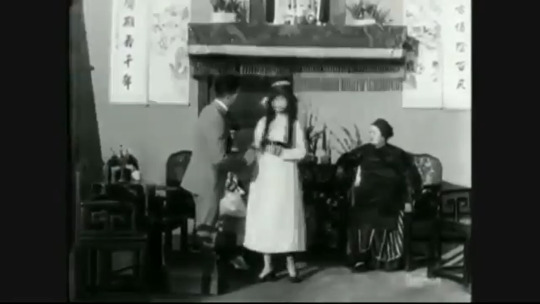
In the opening scene, we see the protagonist played by Violet Wong and her husband (fiancé?) dressed in Western garb, contrasting with the maid and who I assume to be mother-in-law, who wear Chinese fashions. Violet wears a deep hat and an interesting dress with a very high waistline and a hem that shows the ankles and lower calf, a popular cut in that year.

1916 fashion catalogue.
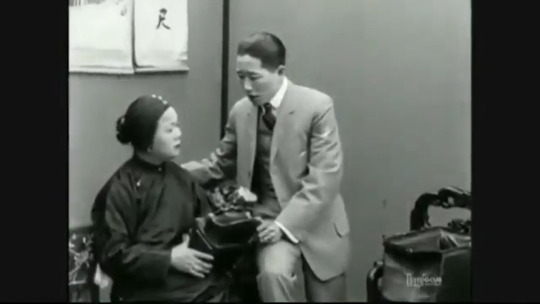
The mother-in-law’s headband is very distinctly late 19th century! Older people tend to wear outdated things, and that’s expressed quite well here.

Photograph of young girls from the early 1900s.


In the hairdressing scene, we can catch a glimpse of just how coarse and fluffy 1910s hair texture was. It's a far cry from the smooth, shampooed hair we see in modern period dramas set in the Republican era. Because of the coarseness, hair could be shaped into very interesting, sculptural shapes that would not be achievable with smooth hair. The protagonist gave herself an updo with voluminous bangs, achieved by backcombing.
The maid also has very intriguing hair. It’s a style seen in some 1910s artworks, but from closeups in the film it could be seen that the front of the hair has been significantly puffed up, either through extensive backcombing or with the use of a hair rat.
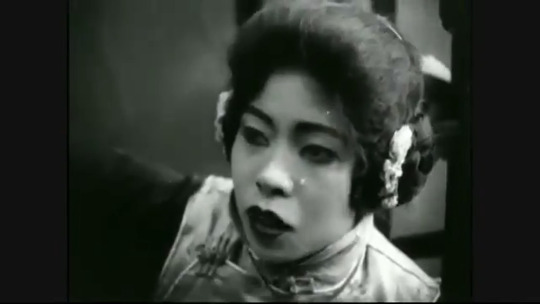
It’s more clear in this later scene. The hair is rough and puffy.
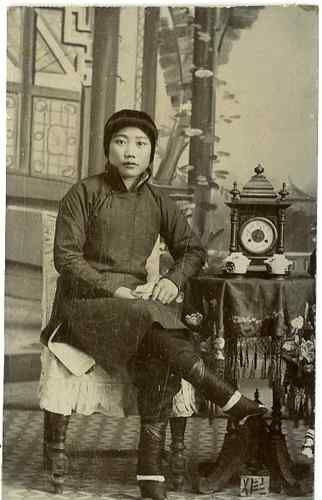
Similar hairstyle in a 1910s portrait.

This is where it gets strange though. The couple gets changed into what looks like theatrical costumes, especially the man’s clothes, for visiting each other’s families during the wedding? Maybe it’s a 1910s interpretation of the pre-Qing Han custom of men getting married in the garb of an official. Violet puts on these shoes with a heel in the middle, which resemble Manchu women’s shoes. It was never stated or implied that she was Manchu though, and Han women have never worn these things, so I find the choice of this costume a bit odd. Maybe it’s a subtle orientalist jab at how impractical and dumb “traditional” Chinese garb is, as seen by Violet later tripping on these shoes.

We see a full body shot of the maid, and she is wearing a typical mid 1910s aoku set, very similar to the ones from The Toll of the Sea I talked about previously.

1910s aoku artifact.

The maids could also wear a sleeveless vest. And we also see the hairstyle with rings of flowers at the sides.

Violet puts on a heavily decorated and tasselled cloud collar, which became an essential wedding item in the late Qing. It also makes an appearance in The Toll of the Sea (pardon my comparing the two films, they’re both American silent films that depict 1910s fashion and have many similarities, so it would be a waste if I didn’t bring it up). The robe worn by Marion, the other character here, is intriguing. While robes with a center front closure were no longer popular since the beginning of the 19th century in popular women’s fashion, it survived in many ceremonial garments, of which this is probably a display of.
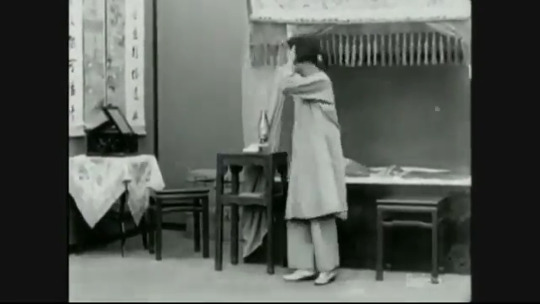
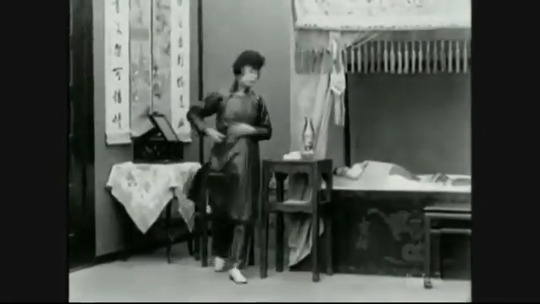
Two clean and sleek aoku outfits.
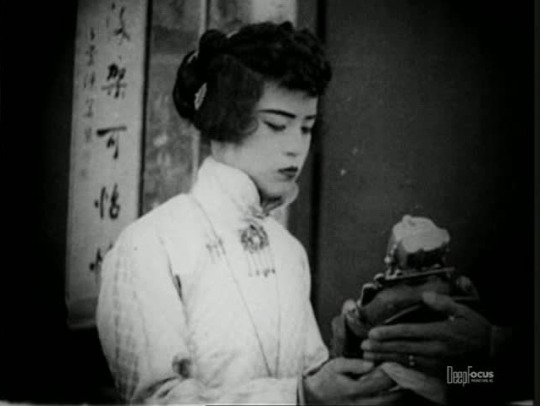
This shot shows perfectly some of the distinctive features of mid 1910s Chinese fashion: the tall “ingot” collar that reaches up to the chins, the tight fit of the robes and the jewellery.

Mid 1910s portrait with similar features.
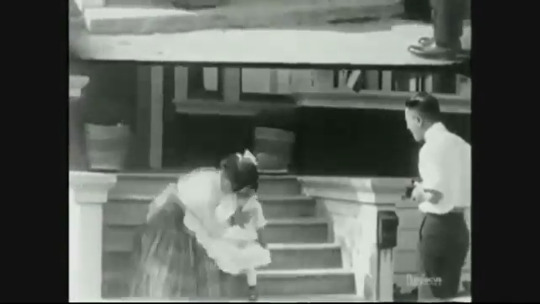

In the ending shot, the couple and their child wear Western fashion, suggesting that they lived happily ever after as Americans. Violet’s puffy blouse plus large plaid skirt ensemble is very typical of 1916.
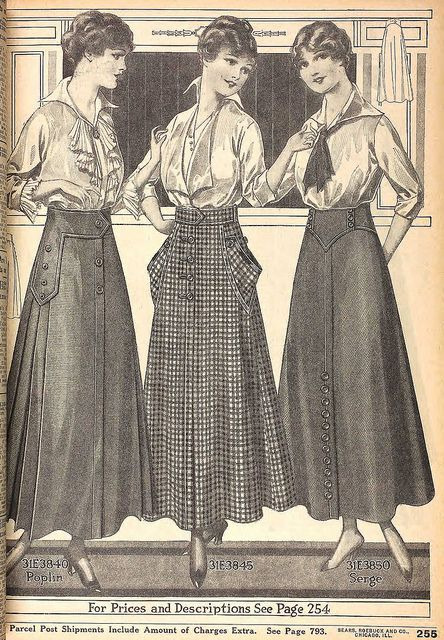
1916 catalogue.
155 notes
·
View notes
Text

Brian Griffin, who has died aged 75, was one of the most original and influential British photographers of his generation. His images of Kate Bush, Donald Sutherland, Iggy Pop and Damien Hirst, and his album covers for Echo and the Bunnymen and Depeche Mode, are some of the most famous pictures of the 1980s.
For the cover of Depeche Mode’s 1982 LP, A Broken Frame, Griffin transposed Soviet social realism to a cornfield off the M11 in East Anglia, and the result was named by Life magazine as one of the greatest images of the decade. His virtuosity saw him declared photographer of the decade by the Guardian in 1989.
His work, which has been exhibited globally, is in the permanent collections of the National Portrait Gallery, the V&A, the Arts Council and the Birmingham Museum and Art Gallery.
Griffin’s success capturing the glossy worlds of money and hairspray was rooted in something darker. He was forged in the Black Country, the industrial heartland of the West Midlands, and the influence of the factories, and the harsh light from the furnaces, suffused his early photography. He had a relentless work ethic and would do anything to succeed in a world far removed from that of his upbringing.
He was born in Birmingham, the only child of Edith (nee Moore) and James Griffin, who were both factory workers. The family lived in a two-up, two-down in Lye, where every street had a factory. Young Brian felt that “the whole world appeared to be partly made of metal. Everything you touched seemed to be iron and steel.” After passing the 11-plus exam he went to Halesowen technical school, then went to work at the age of 16.
In 1965 he was making conveyors for readymix concrete plants when the factory foreman suggested he join Hagley camera club, where he picked up a camera for the first time. He then got a job at British Steel and was working as a nuclear pipework engineering estimator in 1969 when everything changed. Devastated by the end of a love affair, he decided to leave his old life behind.
Griffin’s only means of escape was photography, so he put some of his camera club images into a Boots photo album and applied to art colleges. He was accepted into Manchester Art School at the age of 21, where he studied with Martin Parr and Daniel Meadows.
In the college library he devoured books on art, and after graduating and moving to London, he spent weeks at the National Film theatre immersing himself in German and French cinema. Inspired, he began to look for work.
In 1972 he went to see the art director of Management Today magazine. Griffin’s talent was plain to see, and he was immediately put to work. He shot a shadowy monochromatic image of rush hour on London Bridge from the back of a cab, calling it his Metropolis image, after Fritz Lang’s expressionist masterpiece. Prior to this, Griffin had doubted his ability, but now he knew that he could make it as a photographer, he unleashed his artistry.
Through his images for the magazine, Griffin introduced surrealism to the boardroom. His industrial background meant that he clicked with the businessmen who were his subjects, and the captains of industry played ball. He wittily subverted the corporate power of the men he photographed by introducing discordant juxtapositions, building tension. He wound intrigue throughout his work, stopping the viewer in their tracks, making them take time over his images, and his work began to be recognised.
Ambitious, he wanted to expand his repertoire and earn more money. He understood that the style he had honed in the business world would translate into the pop sphere, where post-punk bands were eschewing bondage trousers in favour of being suited and booted. He went to Stiff Records and photographed Elvis Costello and the Attractions and Ian Dury and the Blockheads.
Recognition followed and commissions flooded in. He worked for Esquire, Rolling Stone, the Face, Time Out, the Sunday Times and the Observer, in advertising for British Airways, BMW and Levi Jeans, and photographed Brian May in a series for Sony Walkman in 1980.
That year he moved to Rotherhithe, a working-class area of south London on the banks of the Thames. He loved the place, recognised its people and was to stay there all his life. He set up a studio from where he continued to push the boundaries of the conventional. Using his background in engineering, allied to his innate creativity, he built lighting machines and used knicker elastic and ping-pong balls to create startling special effects in an analogue age.
Some experiments led to happy accidents: his highly regarded 1984 image of Siouxsie Sioux, intended as a double exposure, was in fact a triple: “It was wrong, but so right,” he said.
In the days before social media, aside from magazines, the main showcase for a photographer’s work was on walls, be they in galleries or town centres. Griffin’s first solo London exhibition was at Contrast Gallery in 1981, and the posters of his work for bands such as Spandau Ballet and Ultravox were plastered across the land. His family finally saw his work and were proud: they had always wanted more for Brian than factory life.
As well as portraiture, he produced numerous documentary projects. In 1986 he photographed construction workers at the Broadgate development in the City of London. At the time he was still reeling from the death of his father from lung cancer, due to a life inhaling cast-iron dust. The project allowed Griffin to pay homage to his father and to all working people: he monumentalised the men “like knights lying in state in a cathedral with their swords”.
In 1989 he left still photography to make television commercials, music videos and short films, but returned a decade later. In 2003 he produced a project to aid Birmingham’s bid to become the European City of Culture. He worked promoting the 2012 London Olympics and in 2015 his photo-essay, Himmelstrasse, movingly documented the railway tracks in Poland that transported people to Nazi death camps. He continued to work up until the end of his life, with new projects still in the pipeline.
He had more than 20 monographs published in his lifetime and won numerous awards. In 2013 the Royal Photographic Society awarded him their Centenary Medal, and the following year he received an honorary doctorate from Birmingham City University for his lifetime contribution to his home city.
Griffin’s 1980 marriage to the photographer Frances Newman ended in divorce. Their daughter, Layla, died in 2020; he is survived by their son, Danz, and three grandchildren.
🔔Brian James Griffin, photographer, born 13 April 1948; died 27 January 2024
Daily inspiration. Discover more photos at Just for Books…?
10 notes
·
View notes
Text
‘Your Name’, Kishotenketsu, and the Power of Storytelling.

(This is a messy little essay, but I just found out a way to watch anime and read manga... and my life as a storytelling fanatic has been the biggest lie in the best way possible. Please feel free to correct me if I got anything wrong, as I'm still new here. - I'm most versed with western stories and Bollywood/Indian cinema. Also when I say 'western stories' I'm generalizing to more of the 'Hollywood Blockbuster' sort of movies, and as far as movies/manga that use kishotenketsu, I've only seen 'Your Name', 'A silent Voice', 'The promised neverland' and I haven't finished 'the Girl from the other side'.)
In 2016, Mikato Shinkai created the film ‘Your Name’, which proceeded to become one of the most beloved movies of the time. This is due to both the storytelling tatics used, along with the intertwined rhetorical strategies. From the differences inherent in the Kishotenketsu storytelling method, to the inspirations garnered from the environment, and the message showcased through its stunning visuals, ‘Your Name’ provides an example of how different methods of storytelling showcase vastly different themes from that of western media, and in turn create a vastly different effect.

An aspect of East Asian culture and storytelling is the emphasis of the world, its beauty, and the effect it has upon those who live in it. For Mikato Shinkai, this became apparent in his inspiration. In 2014 he visited a shrine, which gave him the idea for ‘Your Name’. This shrine visit contrasted with both his visits to Tokyo and his childhood within the countryside, and this dualistic perspective became the basis for the movie’s message. Other motifs of the time also seeped into the movie’s setting and its theme, such as the ‘red string of fate’ often depicted in East Asian culture. This red string symbolizes the idea of both the supernatural and the connection that can come as a result. The first scene of the movie showcases the red string, in which the two main characters of the film - Mitsuha and Taki - become connected after Taki repeats the movie’s title, as he asks Mitsuha for her name. Mitsuha and Taki act as the speakers for the movie’s message, for they are vessels for different aspects of the same message. It’s often this exploration of the world and its relation to the characters that creates a method for delving into the characters and their internal characteristics in a way that is not often seen in western storytelling. In other stories, backstory takes the place of this, yet both accomplish the same goal - ‘Ki’ or ‘introduction’. The point of this introduction is not to introduce the plot,however, as one of the most impressive aspects of Kishotenketsu is how little it relies on a typical plot. Rather, the creator weaves a world and characters that have a history and a past quite quickly. It gives the narrative an air of depth that more plot-based stories would not be able to accomplish in such a short amount of time.
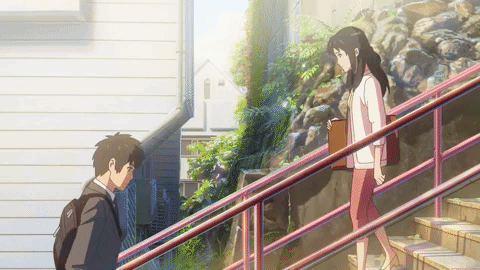
The characters of ‘Your Name’ also differ from western storytelling. Instead of an agent of the plot, or even being a conflicting force with the plot, characters in ‘Your Name’ each embody a different aspect of the overall point. They are characters first, and the story caters to that rather than nudging them to change with the whims of the plot. Mitsuha embodies the idea of perspective. She’s quite shy and polite, and withstands the humiliation of her family’s rituals along with the burden of being the governor’s daughter. Her current life suffocates her, and she wishes for another, more glamorous life within Tokyo. This all shifts when the story changes from the ‘Ki’ or ‘introduction’ stage to the ‘Sho’ or ‘development’ stage. Mitsuha wakes up in Taki’s body, and she experiences a shift in perspective and the life she’s always wanted. Whilst she indulges herself in the life she craved, she also sees Taki’s world through her lens. It’s Mitsuha who connects with Taki’s crush. It’s Mitsuha who enjoys Taki’s life to the point where the others take notice of his difference in personality. It’s Mitsuha who uses her childhood in which she weaved together threads - that symbolizes connection through time - into braids to change Taki’s life for the better. The tone of the film shifts (right before the ‘ketsu’/ ‘twist’ stage) to Taki’s different view on the same message. His point of view - especially when he inhabits Mitsuha’s body - focuses on time and the connections through it. Such as when Mitsuha’s grandmother tells him about masubi - the flow of time and how their work as a priest family is to braid the threads of time together. These dual aspects of the narrative interweave through the two characters in a way that is seamless and allows for a deeper analysis of the message made.

This film caters to people who live in Japan, as both the story structure and the societal expectations differ from western ideals. Because of the ages and desires of the two main characters, ‘Your Name’ specifically caters to the young adult audiences, for they can see themselves within the protagonists and their desire for a different life with different experiences. Those who see their environment as their cage, and who think if they were only able to find another place, another life to live, they may discover that this film speaks to them and inspires them to live as themselves.
Overall, this movie is the tale of two people connected through time via body swapping on random days. This continues through the development phase until Taki discovers the meteor that killed Mitsuha and her town three years ago. It is through their shared perspectives that they not only save the residents of Mitsuki’s town, but they also discover the connection in their past. Through this narrative, Makoto Shinkai wishes to impart on his audience the messages of two interwoven themes: of the differences in perspective over the same event or environment, and how those shared events connect people in time. The first scene established this through the meteor as it painted the sky in brilliant colors. Taki looked upon the meteor with nothing but awe and wonder, yet this is the same meteor that sent Mitsuha to her death. The meteor, despite the destruction it wrought, connected both Mitsuha and Taki, for it is implied that the supernatural of Mitsuha’s world started the events of the movie for the sake of preventing the meteor’s deaths. Similar to the braids that Mitsuha had to weave and the one she gave to Taki at the beginning of the narrative, individuals' lives are connected to these special moments of love and wonder, such as when Taki marveled at the same rituals that embarrassed Mitsuha. Their differences in worldview may cause the threads in their lives to untangle or knot, but they experienced it together. The audience then left the movie with a newfound appreciation for their unique worldview and the small things in their environment that they may take for granted. They are connected to others who will value them, both in their past and when they continue to the future.
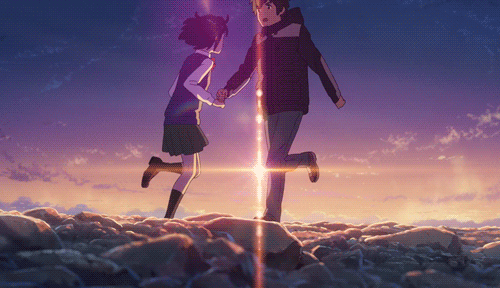
Kishotenketsu allows for a deep analysis on a specific message or a specific perspective, whereas a hero’s journey or a three-act story structure allow for a transformative journey of self-development. Both have their strengths and there is a spectrum of artistic expression and overlap between the two methods. Kishotenketsu, for example, is able to explore a complex theme that surrounds multiple sub-themes- whilst doing so through a close examination of the characters and their world. A story made in the west may be expected to have a greater emphasis on the conflict, lest the audience become bored. This leaves the message and the characters to compete with the plot unless the creator weaves them together. Even so, western stories emphasize change driven by conflict, and they deem a proper story one characterized by a transformation to face an external obstacle. In kishotenketsu there is no difference between any internal or external development, for the character navigating the world and the premise set up in the introduction provides all the development needed.

An example of a western story in which both the plot and the message are interwoven to achieve a transformation is Puss in Boots: the Last Wish. This film explores a fear of death and the anxiety that comes with this. Through the change in the main character, the audience - who may also share this experience, as it is deeply personal to the creators - learns the lesson of living life to the fullest instead of running from fear. This is not a lesser story structure by any means, but it does serve a different purpose. This structure is meant to provide an example to the audience about how to grow from flaws or limitations, whereas kishotenketsu is similar to its poetic roots in its overall purpose. These stories do not need character transformations or a removal of flaws - such as in ‘Your Name’ where both Taki and Mitsuha forget the events of the film - instead they look at life and depict it as beautiful art and magical stories. The story is allowed to spend time with the mundane and the characters, and it leaves the audience with an impression and an appreciation of the world. It’s a new perspective, a new way to look at life, and the message is left to personal interpretations. (Rarely is the message ever outright said. The message in western stories is much more obvious and apparent). Kishotenketsu showcases the wonder of life, as it is, in the present - no change required.
#anime and manga#animanga#manga#your name#miyamizu mitsuha#makoto shinkai#kishotenketsu#storytelling#essay writing#in this essay i will#discussion#media#essay
7 notes
·
View notes
Text
underground idol #1, yoojung's 'begin' and wong kar-wai's chungking express
since the video teasers started dropping this week, some lyons have been noticing that the 'begin' mv seems like it takes some inspiration from wong kar-wai's films, especially chungking express
for those who don't know, wong kar-wai is a v influential director of hong kong cinema known for his distinct visual style involving saturated color grading and easian cityscapes and a non-linear storytelling style that is heavily character and emotion-focused, often telling stories of love, loss, romance, yearning, and sensuality
ooo are no stranger to wkw references and inspiration in their work, the most obvious being the posters for in the mood for love, happy together, and 2046 in the background of the unknown art pop 2.1 shoot

(happy together, abt a tumultuous, tragic relationship, which ooo is also no stranger to in their work, is perhaps one of the most pivotal films of east asian lgbt cinema)
from the teasers, 'begin' definitely has a lot of that saturated coloring focused on enhancing the colors of the city lights you see in wkw films

and from what we've seen, it looks like there are definitely a lot of references to wkw's chungking express, which tells two stories. begin seems to be mostly referencing the second story in the film, centered around a hong kong cop and the server at a cafe he frequents, since we have yoojung working in a diner and kb as someone who visits






the server at the cafe, faye, also wears this spring yellow a lot, which would explain why taeyeob got the yellow branding for his solo, as opposed to wookjin, if all the solos are getting different colors (which is smth ive been wondering since u know, yellow is like wook's signature color)

and on the day the first video teaser was released, jaden jeong, their creative director who is in charge of their lore, among other things, posted this picture of aquarium fish with 'begin' lyrics as the caption (the same lyrics that are in the description of the teasers), and fish are a motif that appear frequently in chungking express (also as a side note, jaden's ig was private for a long time until this post)

so that's a quick rundown on the wkw references so far in begin!!
and as always, many many thanks as always to fiona @iridescentspacewhale; he was actually the one who had seen chungking express before me and pointed out a lot of these when the teasers first dropped (i only just watched it tn despite it having been on my watchlist for months, v good btw, do recommend)
#me: let me just write a quick post about x#me: spends the next hour on the post#anyways#i think im gonna make a gifset of the parallels once the mv actually comes out#but i wanted to get this out before the mv bc fiona and i have been talking a lot abt it#and im sure some ppl would find this interesting n want to look out for references when the mv comes out <3#anyways mwah mwah happy begin weekend <3#(ik it's technically out monday but it's 2am for me so basically sunday night)#onlyoneof#ooo#lee taeyeob#yoojung#shin kyubin#kb#ooo lore#kinda?#also btw idk if you guys have noticed but generally in these lore posts#i'll be using stage names for their characters and real names for the members themselves#just to make it easier so i dont have to keep typing 'taeyeob's character in x mv' etc etc#ennuitxt
84 notes
·
View notes
Text

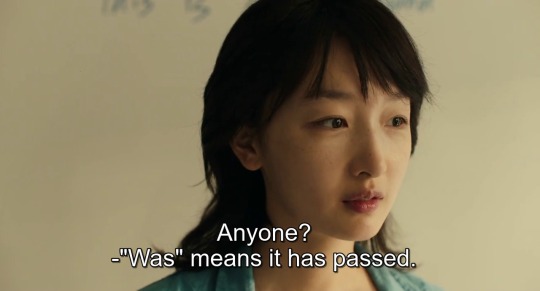
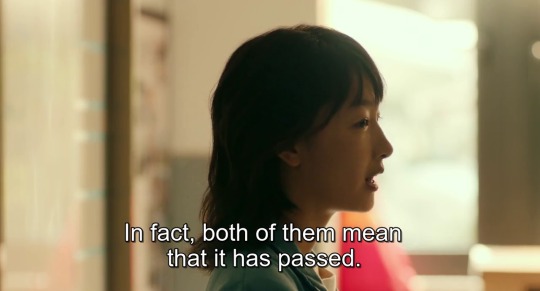

少年的你 [Better Days] (Derek Tsang, 2019)
#少年的你#Better Days#Derek Tsang#Shao nian de ni#drama film#teenagers#Chinese movies#People's Republic of China#送我上青雲#Chinese society#Chinese people#lovers#Far east cinema#Zhou Dongyu#周冬雨#Jackson Yee#易烊千玺#high school#bullying#friends#police#college entrance exam#prisoner's dilemma#Beijing#Yin Fang#family#vendetta#detectives#teachers#past
9 notes
·
View notes
Text
I've been revisiting youtubers recently. some I like under the cut
Folding Ideas: a marvelously well-spoken social and media critic, with commentary on symbolism in film. his breakdowns of the editing failures of films such as Suicide Squad and The Snowman are entertaining and informative, and he has mini-episodes on narrative concepts like Thermian arguments (the Watsonian of Watsonian vs. Doylist explanations) and ludonarrative dissonance. politically on top of it (mostly), extremely astute, and a pleasure to listen to. See Earthsea and Adaptation Sickness, End of Evangelion and the Audience Author Membrane, The Thermian Argument, The Art of Editing and Suicide Squad, Cinematic Trainwreck – The Snowman: A Vlog, Cooking Food On The Internet For Fun And Profit, Annihilation and Decoding Metaphor
Ariel Bissett: a delightful young Canadian book reviewer takes us on her journey of renovating her old house. mostly cosmetic changes rather than structural as she's essentially self-taught, but she's a charismatic and charming host with a unique eye for style and color. her design sense matches closely with my own (we're both Monet fans), so I find her videos very soothing and satisfying to watch. I haven't seen any of her book reviews, but she seems thoughtful and passionate. I like all her house videos, but particularly the three yearly house tours so far (intro video, one year in, two years in,), Building The Perfect Guest Room, Complete Office Renovation!, Living Room Renovation To Look Like Emma's House!, Building The Perfect Reading Nook, Transforming the Smallest Room In My House With Wallpaper, and honestly all the others. it's a real pleasure to see the changes she makes over the months. I can't wait for the kitchen redo!
Accented Cinema: probably my favorite youtuber right now. he's a Chinese Canadian filmmaker with a focus on films and film-making processes, both his own and those from China (most often) and other non-American countries (occasionally). his videos have brought me to tears more than once. honestly I love too many to list all of them so I'll just list my top favorites but I highly recommend this channel. I loved Why China Cared About Kung Fu Panda, Shadow: Adapting Chinese Art, Who Killed Captain Alex: What Makes a Movie Good?, Chinese Animation: In Search of a Style (brief shot of mdzs donghua at the very end), Why Ghibli's First 3D Looks Soulless, East vs. West: Differences in Story Philosophy, Mahjong & Crazy Rich Asians, Why Are Kung Fu Movies So Patriotic, How I Made a Fake Video Essay
Local Script Man: a professional screenwriter whose advice and commentary on creating stories is really interesting and different than what you tend to see on tumblr. he tends to be kind of harsh but not in mean-spirited way, just in a way that makes it obvious that he knows what he's talking about. I like Oops No Plot, The Key to Writing Freakishly Good Dialogue, and both parts of 5 Essential Storytelling Rules I Just Made Up (part 1, part 2)
Schaffrillas Productions: a guy breaks down and ranks various animated films, often by studio. these videos are just a lot of fun. I liked his videos on the Shrek franchise (one, two, three, four, and the musical), and Raya vs. Encanto - How One Message Failed and Another Succeeded
Super Eyepatch Wolf: this man is, as we speak, convincing me to read Berserk. he has a slow, dramatic presentation of his arguments that draw you in and a great sense of humor. All of his "Why You Should Watch" videos are interesting even if you don't have any plans to watch the show he's describing, because they give an overview of the themes and strengths without spoiling it. he also presents a wealth of information on manga/anime history, and miscellaneous commentary on other media. I liked in particular The Fall of The Simpsons: How it Happened, "Non Battle" Battle Anime, What Makes A Fight Scene Interesting?, The Impact of Dragon Ball Z: The Series that Changed Everything, Why You Should Watch Yu Yu Hakusho, What Makes A Good Character Design?,
Cinema Therapy: these two guys are charming and sometimes funny. they can get annoying and their analyses tend to be very superficial, but I really like their videos tearing into bad romantic cliches. I like 10 TROPES We Hate About Rom Coms, 7 Tips from THE ADDAMS FAMILY to Keep Your Marriage Alive, TITANIC: Love Triangles and Compatibility, Therapist Reacts to THE KISSING BOOTH (Part 1, Part 2), Relationship Therapist Ranks Christmas Romances with guest Shona Kay
Sideways: a channel about music! knowing nothing about music at all, I find these videos really interesting and accessible. see Why the Music in Cats (2019) is Worse than you Thought, Why Pipe Organs Sound Scary, Decoding the Music of The Matrix, Why Avatar has the Most Ironic Soundtrack of All Time, Why the Soundtrack to Shrek is Actually Genius, Ear Training and Sight Singing: The Superpower you get from Music School, Why "Spoken Word" Makes me Nervous
Pop Culture Detective: I like this channel for the analyses of troubling tropes in media, especially the ones on misogyny. See Marvel Defenders of The Status Quo, The Ethics of Looking And The “Harmless” Peeping Tom, Born Sexy Yesterday, The Complicity of Geek Masculinity on the Big Bang Theory, Sexual Assault of Men Played for Laughs (Part one, Part two), Stranger Things, Belligerent Romance, and the Danger of Nostalgia
favorite misc videos here
7 notes
·
View notes
Photo







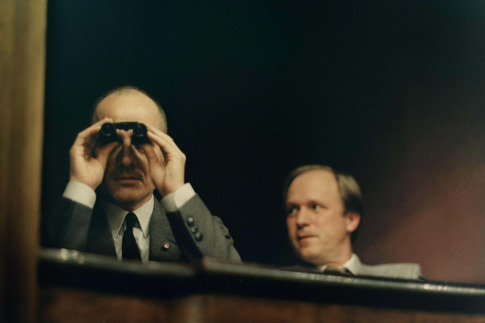
SUBLIME CINEMA #629 - THE LIVES OF OTHERS
When asked in an interview how he prepared for the role of GDR Stasi captain Wiesler, the late Ulrich Muhe simply said ‘I remembered’. He was an East German actor and activist who himself was spied on and betrayed by a former wife; he didn’t have to travel far to evoke the perfect performance he delivered in this masterpiece.
#film#movie#filmmaker#films#cinema#Florian Henckel von Donnersmarck#the lives of others#filmmaking#movies#cinematography#germany#german cinema#stasi#communism#east germany#east german#east german actor#cinema of germany#great film#cinephile#academy award#oscar#police state#gdr#berlin#berlin wall#east berlin
45 notes
·
View notes
Note
babe what were the riots in shields in the 90s??
Okay so I'm not actually sure but I'm presuming it's this? One of the worst riots in British history apparently. Started in an estate over the deaths of two lads who were in a car crash when fleeing the police.
The historic context, from what I can tell, is the same as most unrest in UK. Was fuelled by hatred for the police that had been brewing since Thatcher and the miners strikes.
The estate was built as spillover when they overhauled all the slums (they did this in Scotland too and created some of the most miserable places you've ever seen). Mostly what you find with spillover estates is that they're just like a box to put the poor people in out of sight out of mind to kind of keep them contained so you can forget about them? They end up being derelict, poverty stricken, often quite lawless dangerous places to live, people who grow up there end up trapped there by their circumstances, there's quite commonly high suicide rates in these places. Billy Connolly talked about the Glasgow ones in a documentary and described the problems quite well, they build all these tiny houses and move as many people into them as they can, get them out the slums, but they don't build shops or cinemas or cafes, no parks or green spaces, nowhere for anyone to go, nothing for them to do, no jobs for them to work etc, they just leave you there to rot kinda thing.
Then you combine this with the context of 90s north east, the miners strikes and thatchers police/military violence against the working class is still an open wound, anger against the authorities is already high and probably for the people in those estates, getting more tense day by day. Because it's the government and the police that keep you trapped in those places.
I saw this stat from 2021 (but this issue has been a problem for a long time, probably since before thatcher but certainly exacerbated tenfold by her)
(and it gives you context for songs like Dead Boys too)

This is the data for suicide rates across the country, London and the East/South east have the least which is honestly no fucking surprise at all. Generally those are the most affluent areas of the country. There's still jobs and an economy and it's where ALL the money goes.
Once you get to West Midlands and up you're above the average suicide rate for the country too which is not fucking surprising either.
Anyway the reason I added this to useful context about the riots in the 90s is that like, for all that there was a keep quiet don't talk about it culture (I say was because it was worse then) about suicide, it wouldnt mean people weren't angry.
So like when two lads died in a police car chase (which is awful anyway but also the police have a duty/responsibility not to risk loss of life even to suspected criminals obviously) it wouldn't just have been anger about that which set of the chain of events if that makes sense? Like general anger among a disillusioned and downtrodden demographic which is then sparked by one inflammatory incident is usually what causes a riot.
Anyway the riots were really bad, derelict houses, and shops (there was a lot of racially motivated hate crimes too apparently) were burnt down, the high street was left in ruins. The rioting spread quite far too.
"the fallout" from the riots is probably like, intensified tensions with the police in that area, a lot of fear and anger in a community, a fuck tone of people went to prison, governments punish towns for this shit and the Tories would have been making so many cuts to every kind of social service and giving the money to the cops instead, like just generally economic downturn and stuff. When he talks about cranes being static like, Thatcher destroyed most UK based industry, there were no jobs anywhere. But also right and this is something I think people forget to consider, the fallout post these strikes and riots was a sense of crushing hopelessness because we didn't win. The police and the government won and crushed the communities who had rebelled. Ultimately the fallout is an overwhelming sense of loss, grief, anger and the knowledge that there's no point fighting it cause when you fight the government come down harder, threaten your families.
The whole of the estate ended up being either rebuilt or refurbished and theres a new community center too now, so he could also remember seeing stuff being rebuilt, but I don't get the impression that's what he's talking about somehow.
Theres a TV show called boys from the blackstuff set in Liverpool (I think) that's kind of about this, how there was no industry and everyone was on the dole which wasn't enough to feed a family on, so people would try to work sneak jobs on the side (which lead to so much abuse of workers, kids in unsafe environments, deaths) because if you aren't even like 10p your dole would get stopped. Again all of it leads to suicides and violence. You can watch it on ITV player I think and if this stuff is something you're interested in beyond a Sam Fender lyric you should watch it, it's really emotive and like makes you angry but it really shows you how evil the Conservatives are and how their evil really remains everywhere. (and it explains so much about the north South divide and why there are kids being raised right now up north who will not forgive and forget for the sake of making friends with a southerner when they go to uni)
2 notes
·
View notes
Text
Let's just save everyone some time and annoyance. Instead of posting my entire Spotify library one track a time, cluttering up your dash, here's my top 200 songs (minus the X-Files soundtrack...) so that those who care can look.
Top - Live
Carry on Phenomenon - Kishi Bashi
Gillian Anderson - DeRita Sisters
T.B.D. - Live
Philosophize In It! Chemicalize In It! - Kishi Bashi
The Sandman - PJ Harvey
All Over You - Live
Fall - Davido
Crystal Ship - The Doors
Everyday - Weyes Blood
Shit Towne - Live
Sylvia - The Antlers
Theme for Scanty and Knee Socks - TeddyLoid
Fighting With the Melody - Jimmy Urine
Prometeme - Monsiuer Perine
Doctor Blind - Emily Haines and the Soft Skeleton
Selling the Drama - Live
Bad Girls - Donna Summer
Paralyzer - Finger Eleven
Get It Up - MSI
Stage - Live
Hollywood Baby - 100 Gecs
Fourth of July - Sufjan Stevens
Jesusland - Ben Folds
Broken - UNKLE
Like a G6 - Far East Movement
Sober - Fidlar
A&W - Lana Del Rey
Twilight Time - The Platters
Witch - the bird and the bee
The Perfect Drug - NIN
Mulder and Scully - Catatonia
Concerning the UFO sighting - Sufjan Stevens
Freezing - Mozella
Epilogue - The Antlers
I Alone - Live
Never Wanted to Dance - MSI
A Lot's Gonna Change - Weyes Blood
Iris - Live
Obstacle 1 - Interpol
Jinja - Olamide
The Heaviest Matter of the Universe - Gojira
The Less I Know the Better - Tame Impala
Waitress - Live
Starman - David Bowie
Death is a Girl - Mini Mansions
My Gun - Tove Lo
TAIL - SUNMI
Sheisty - Trinidad James
Come on Eileen - Dexys Midnight Runners
Close to You - Carpenters
Eventually - Tame Impala
Never Let Me Down Again - Depeche Mode
The Dam at Otter Creek - Live
Intro/Pathos, Pathos - Kishi Bashi
Mulder, It's Me - Roach Coach
Take What's Mine - Baumer
Patty Hearst - Jimmy Urine
Oblivion - Grimes
Wonderboy - Tenacious D
Andromeda - Weyes Blood
MY GOD! - Tessa Violet
Enjoy the Silence - Depeche Mode
Here Comes the Hotstepper - Ini Kamoze, Salaam Remi
Volverte a Ver - Monsieur Perine
Get Over It - OK Go
money machine - 100 Gecs
Knife Prty - Purity Ring
Loser - Beck
I-E-A-I-A-I-O - System of a Down
Gasolina - Daddy Yankee
Scroll Patrol - Rinse and Repeat
Sleep - Conjure One, Rhys Fulber
Every Third Thought - David Duchovny
Somebody's Watching Me - Rockwell
Attack - System of a Down
Seether - Veruca Salt
Fucking Boyfriend - the bird and the bee
Something Good Can Work - Two Door Cinema Club
Funkin' Around - Outkast
867-5309 - Tommy Tutone
Attitude - Buggin
Son of Sam - Elliot Smith
Goatmeal - LustSickPuppy
RIDE IT - LustSickPuppy
Space Oddity - David Bowie
All I Really Want - Alanis Morissette
She Blinded Me With Science - Thomas Dolby
The Government Knows - Knower
Don't Worry About the Government - Talking Heads
Somewhere Only We Know - Keane
Crystal Ball - Keane
Life on Mars? - David Bowie
Road to Nowhere - Talking Heads
She's An Angel - They Might Be Giants
Sci-Fi Wasabi - Cibo Matto
Yours Truly, 2095 - ELO
How to Disappear Completely - Radiohead
In the Backseat - Arcade Fire
Oh Comely - Neutral Milk Hotel
La Mer - NIN
Burn the Witch - Radiohead
Galaxies - Laura Veirs
Scientist - The Dandy Warhols
Stella was a diver and she was always down - Interpol
Hurt - NIN
Female of the Species - Space
Lithium - Nirvana
Black - Pearl Jam
Karma Police - Radiohead
Hungry Like the Wolf - Duran Duran
Who Can it Be Now - Men At Work
Gila Monster - King Gizzard and the Lizard Wizard
The Boy with the Thorn in His Side - The Smiths
Live Fast, Diarrhea - The Vandals
Screaming Infidelities - Dashboard Confessionals
OG! - JPEGMAFIA
MakeDamnSure - Taking Back Sunday
Freak Mode - Dorian Electra
Welcome to Earth (Pollywog) - Sturgill Simpson
Origin of Love - MIKA
The Curse of Curves - Cute is What We Aim For
love nwantiti - CKAY
Adore You - Miley Cyrus
On & On - Longpigs
Dumb - KOPPS
Anubis - Septicflesh
Girls on Film - Duran Duran
Friday I'm in Love - The Cure
Andrew in Drag - The Magnetic Fields
Water of the Gods - The Changes
La Gozadera - Gente De Zona
Violent Pornography - System of a Down
You Sexy Thing - Zella Day
Heart Burn - SUNMI
Party Time - The Northern Boys
Dani California - Red Hot Chili Peppers
Island in the Sun - Weezer
Babooshka - Kate Bush
Californication - Red Hot Chili Peppers
What Kind of Name is Love – Big Kid
Hacker – Death Grips
Space Age Love Song – A Flock of Seagulls
The Way We Talk – The Maine
Walking on a Dream – Empire of the Sunday
Neighbour – Mother Mother
Slow Dancing – Aly & AJ
To the Hellfire – Lorna Shore
Los Ageless – St. Vincent
So Hot You’re Hurting My Feelings – Caroline Polachek
Me and Bobby McGee – Janis Joplin
The Message – Grandmaster Flash
Maria – HWASA
Mothercreep – FKA Twigs
Locket – Crumb
When You Die – MGMT
I Want You – Mitski
Ghost Town – The Specials
joke! - SE SO NEON
You Oughta Know – Alanis Morissette
Propagation – Com Truise
No Rest for the Wicked – Lykke Li
Genghis Khan – Miike Snow
Kettering – The Antlers
Just Say Yes – Snow Patrol
Take a Walk – Passion Pit
Major Tim – Shiny Toy Guns
Neighborhood #2 (Laika) – Arcade Fire
Genius Next Door – Regina Spektor
More Than Words – Extreme
Creature Comfort – Arcade Fire
Dark Red – Steve Lacy
Let It Happen – Tame Impala
Crimewave – Crystal Castle
Church – Aly & AJ
Better Things – Passion Pit
Tulsa Jesus Freak – Lana Del Rey
cellophane – FKA Twings
Insane in the Brain – Cypress Hill
Me and My Husband – Mitski
Duality – Slipknot
Send Me an Angel – Infected Mushroom
Lady – Regina Spektor
Girl Loves Me – David Bowie
I’m Yer Dad – GRLwood
Hollywood Junkyard – The Bobby Lees
Disco Heaven – Lady Gaga
Helplessness Blues – Fleet Foxes
Such Great Heights – The Postal Service
In Cauda Venenum – The Dear Hunter
The Other Side – Pendulum
Bruma – MOL
Alrighty Aphrodite – Peach Put
Prince Johnny – St. Vincent
Shake It – Metro Station
You Are the Right One – Sports
Now We Can See – The Thermals
Body – Mother Mother
Kids – MGMT
I Will Possess Your Heart – Death Cab For Cutie
4 notes
·
View notes
Text
Season of The Witch (Steve Harrington x OC)

Chapter Fourteen: Escape from Alcatraz
masterlist-about-patreon-ao3
Revised 5/13/23
Summary: It’s then that Hopper takes notice of the girl's attention now on him, eyes cast upward to meet his gaze and for just a moment, he feels that familiar tug on his heart. A tug that brought him back to that hidden away box, brought him back to those sorrow filled eyes of his daughter as she suffered through the torture he poisoned her with. But Sara was gone, and the girl sat before him held secrecy, and fear in those eyes, something unseen holding her back.
Warnings: Soft, young Steve, mentions of death (esp death of a child)
Word count: 1,928
Do not repost without proper credit or permission
Hawkin’s, Indiana.
There wasn’t much to say about the community, though few words always came to mind as you passed through on your travels, one being, small. It was peaceful, a close knit town with just about everything one could need all bundled up in the center of it all. The busiest of days for shoppers still felt like a breath of fresh air, enough elbow room as you walked and never feeling as though you were in someone’s personal space. From the buildings, to the room spared between houses and your everyday errand runners, Hawkin’s was a stark contrast to a life left behind for Hopper. New York City was as dazzling as it was unsettling. Buildings stood tall in the clouds, the idea of looking outwards to only see cars the size of ants moving slowly through traffic was enough to leave your stomach turning. On the ground, the streets were stretching beyond capacity with busy bodies trying to get to work, trying to make a living as something they’ve only fantasized of, chased after. The city of dreams, and soul crushing disappointment.
For some, pain. Unimaginable heartache where the only solution seemed to be abandoning it all together. Taking every memory ever made and cramming it all into a single box, to be forgotten about and never spoken of. The memories only returning in the form of nightmares, ripping at the wounds struggling to heal. That’s why Jim Hopper had left his larger than life home, favoring isolation within Indiana to shuffle pieces of a shattered heart back together. Not whole, but just barely there to survive. Handling every minor shoplifting report or fender bender with ease, thankful to be here and not amongst the bodies left at the homicide unit back North East.
“Hopper,” Florence calls, looking just as annoyed as she had been at the start of her shift, no joy in sight despite the hours coming to an end. “What?”
His feet are kicked up on the desk like most nights, chair tilted back for easier relaxation, digesting his meal of Cheeseburger and fries picked up on the way back to the station from dealing with loiters around some family business. The wrapper was scrunched up, tossed upwards to the ceiling before falling with ease back into his other hand, passing the time between calls and at risk of calling it an early night. Surely there was a date out there, somewhere. Waiting for some lonesome fool just like him to stumble into the bar with clear intentions of inviting her home, but to never speak again.
“Got a little problem down at the cinema. Something about a couple of kids needin’ help,” she states, lingering in the doorway in wait for his response. “What kind of help? Is it bad?” he asks, eyes still on the paper ball as it soars. “M’not sure, I don’t think so. The girl that called seemed more annoyed than anything. Now get your ass moving, it’s getting late.” Her tone leaves him sighing, still leaned far back before tossing the paper off to his side, watching it bounce off the rim and scatter across the floor. He’d pick it up later. Maybe even tomorrow.
A tightlipped cigarette hangs from his lips for the duration of his drive, inhaling the addictive toxins and letting the smoke cascade from his nose like a waterfall, easily slipping through the cracked window just at his side. The cinema wasn’t far from the station, with everything big and important just at your fingertips in this town. And at first glance of the glimmering sign just at the corner, he doesn’t see anything out of the ordinary. No kids, no ruckus. A few pairs whether romantic or not lining up for a ticket at the booth. His Chevy just parked across the street, its presence drawing a few wandering eyes and murmurs as he makes his way toward the building, a polite nod given to the teenagers just trying to hide away and stay off of his radar. Inside, it’s as busy as you can get on the weekend. It seemed as though the town was gathering here for their favorite new release, watching with eager eyes as their popcorn was shuffled into bags. The walls were glowing with multiple posters to advertise their showings, some standing to ogle at the art and relive the experience with friends after just seeing the show.
Hopper was at a total loss the moment he stepped into that lobby, overwhelmed by the foot traffic. And then he sees them - two kids sat on a bench just near the restrooms, one wearing a heavy pout and a clear look of annoyance while the other seemed to stare out into nothing, eyes burning holes through the carpeted floor. Standing above them, a teenager with arms crossed over the red Hawk jacket, an obvious employee that immediately waves him down the moment their eyes meet.
The boy's demeanor doesn’t seem to shift as Hopper closes in - if anything, he seems more alert and bright eyed, giving his friend a gentle nudge to the arm though her gaze only shifts to look towards the windows where people gather in line outside. “Thank god you’re here,” the girl expresses in an exhausted tone, arms falling to her side. “I’m supposed to be working, but instead I have to babysit.”
“No one asked you to,” the boy bites back, unafraid despite the obvious age and height difference between the two. “You did, brat. You’re the one that came up to the counter asking for help.” She stares him down, the situation looking all too comfortable for the teen as though she had a younger sibling waiting back home for her, ready for another verbal battle. “I only did that because-” he starts, quickly cut off by a tired, and frankly bored Jim Hopper. “Enough, enough. You,” he begins firmly, eyes directed at the employee with intensity until arms cross back over, creating a barrier from his intimidating look. “What happened?”
“Honestly, hell if I know. This kid comes running up to the counter saying he needed help for his friend,” her fingers lazily wave towards the young girl, still lost in her own thoughts. “I tried t’ask what happened but he wouldn’t shut up long enough-” “Like you cared anyway.” The girl was ready, lips parted and a retort just on her tongue to fire back at him, but Hopper let out an aggravated sigh, sending the two into silence. “I’ll take it from here.” “Good, now I can get back t’my actual job,” the girl blurts out, turning on her heel the moment the invisible bonds had been set free, allowing her to return to the counter.
The Chief of police looks down to the two kids, the girl not yet giving any attention towards the situation while the boy appears more annoyed with every passing second. He wanted help, but he hadn’t expected to be interrogated. “What’s your name?” Hopper begins, making an attempt at building that trusting relationship so he could speak freely. “Steve,” the younger says without hesitation, before gesturing to the girl at his side. “This is Aut - I mean, Autumn.” Hopper’s eyes find the girl, still lacking the connection as she stared off elsewhere, small arms wrapped tightly around her form. “Is this the friend you needed help with?” Steve nods wordlessly, a single curl from his neatly kept hair falling loose to hang across his forehead. The man gets down to their level, knees aching the moment he squats down to appear less of a threat to them. “What happened to her?” The boy looks to her, hoping to hear her voice - to explain what she was going through, but he was left with nothing, leaving him to tell her story the best he could.
“We went to see a movie-” he starts. “What movie?” Steve is shifting in his spot, thumbs fiddling with one another as he attempts to avert his eyes from the man before him. “E-Escape from Alcatraz.” This news has Hopper’s brows raising with amusement, fighting off that small smirk wanting to creep forward. “Little young to see that movie, aren’t you? What are you, ten?” he questions, watching as the boy's attitude changes, becoming more defensive. “We’re thirteen,” he bites back, the roll of his eyes hard to ignore. “Well, I’m going t’be thirteen-” he continued. “You know that movie is PG, right? Where are your parents?” Another look of irritation washes over the boy, nearly regretting asking the girl up front for any assistance. “Parental guidance is suggested,” is his retort, his small frame slumping backwards until it hits the wall. A smile finally cracks through, though he does all he can to stow it away the moment it slips by, hiding it behind a hand that tugs at the muscles until they settle down. “Okay, kid. Tell me what happened.”
A look of uncertainty falls on the girl, unsure of where to begin. “She got scared, or something-” “Scared?” He nods in response, forcing himself to sit forward, confidence seen in his posture. “She was fine earlier. She wanted t’see the movie. But, I don’t know.. Something changed.” Hopper waits with patience, tilting his head to encourage the boy to continue his story. “She just froze up. Crying, but.. Just stuck, like a statue. Like she wasn’t really there,” again, deep brown eyes are cast her way expectantly, but all she does in response is kick her feet gently into the floor. “I tried talking t’her, but she.. I don’t know. She couldn’t hear me or something. I was worried something might happen.” His tone is soft, sympathetic, and full of fear as he relived the moments her grip tightened on his arm, nails digging into his flesh until he was able to slip free, trying to pull her back into reality. “Something like what?” Hopper asks, now studying the girl who seems to have fully come to her senses. “That she might faint again.”
“Faint?”
Steve nods. “She gets sick sometimes. I’ve seen it before - it’s scary. But her dad is usually there to help -” “And where is he now?” he asks, the ache in his bones intensifying the longer he stays low to the ground. The boy shrugs, “My mom dropped us off, she’s supposed t’come back and get us after the movie.” With a groan, the officer finally stands tall with hands on his hips. “How about we wait for you mom to come back, yeah? Make sure you two get home alright,” he offers up, coming to a loose conclusion that this boy's friend may have gotten more than she bargained for, scaring herself by the intense scenes of the movie and now too afraid to admit she was in the wrong for being here. “What about her?” He raises a brow down at the boy, curious. “She hasn’t said a word to me since. M’worried about her,” he continued.
It’s then that Hopper takes notice of the girl's attention now on him, eyes cast upward to meet his gaze and for just a moment, he feels that familiar tug on his heart. A tug that brought him back to that hidden away box, brought him back to those sorrow filled eyes of his daughter as she suffered through the torture he poisoned her with. But Sara was gone, and the girl sat before him held secrecy, and fear in those eyes, something unseen holding her back.
#steve harrington#steve harrington x oc#steve harrington x original character#steve harrington x reader#steve harrington fanfic#steve harrington fanfiction#steve harrington slow burn#steve harrington angst#stranger things fanfic#stranger things fanfiction#jim hopper#hopper
9 notes
·
View notes